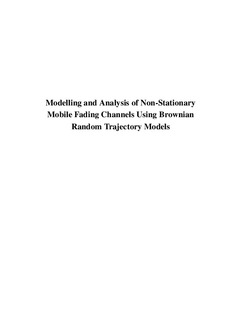| dc.description.abstract | The demanding mobility features of communication technologies call for the need
to advance channel models (among other needs), in which non-stationary aspects
of the channel are carefully taken into consideration. Owing to the mathematical
complexity imposed by mobility features of the mobile station (MS), the number
of non-stationary channel models proposed in the literature is very limited. The
absence of a robust trajectory model for capturing the mobility features of the MS
also adds to the depth of this gap. Not only statistically non-stationary channels, but
also physically non-stationary channels, such as vehicle-to-vehicle channels in the
presence of moving scatterers, have been rarely investigated.
In the literature, there exist two fundamental channel modelling approaches,
namely deterministic and stochastic approaches. Deterministic approaches, such as
measurement-based channel modelling, are known to be accurate, but site-specific
and economically expensive. The stochastic approaches, such as geometry-based
channel modelling, are known to be economically inexpensive, computationally
fair, but not as accurate as the deterministic approach. Among these approaches,
the geometry-based stochastic approach is the best to capture the non-stationary
aspects of the channel. In this dissertation, we employ the geometry-based stochastic approach for the
development of three types of channel models, namely stationary, physically nonstationary,
and statistically non-stationary channel models. We geometrically track
the plane waves emitted from the transmitter over the local scatterers up to the receiver,
which is assumed to be in motion. Under the assumptions that the scatterers
are fixed and the observation time is short enough, we develop the stationary channel
models. In this regard, we propose a unified disk scattering model (UDSM),
which unifies several well-established geometry-based channel models into one robust
channel model. We show that the UDSM is highly flexible and outperforms
several other geometric models in the sense of matching empirical data. In addition,
we provide a new approach to develop stationary channel models based on
delay-angle joint distribution functions.
Under the assumption that the scatterers are in motion and the observation time
is again short enough, we develop a physically non-stationary channel model. In
this connection, we model vehicle-to-vehicle (V2V) channels in the presence of
moving scatterers. Proper distributions for explaining the speed of relatively fast
and relatively slow moving scatterers are provided. The statistical properties of the
proposed channel model are also derived and validated by measured channels. It
is shown that relatively fast moving scatterers have a major impact on both V2V and fixed-to-fixed (F2F) communication links, as they are significant sources of the
Doppler spread. However, relatively slow moving scatterers can be neglected in
V2V channels, but not in F2F channels.
Under the assumption that the scatterers are fixed and the observation time is
not necessarily short anymore, we develop the statistically non-stationary channel
models. To this aim, we first introduce a new approach for generating fully spatial
random trajectories, which are supposed to capture the mobility features of the MS.
By means of this approach, we develop a highly flexible trajectory model based
on the primitives of Brownian fields (BFs). We show that the flexibility of the
proposed trajectory is threefold: 1) its numerous configurations; 2) its smoothness
control mechanism; and 3) its adaptivity to different speed scenarios. The statistical
properties of the trajectory model are also derived and validated by data collected
from empirical studies. We then introduce a new approach to develop stochastic non-stationary channel
models, the randomness of which originates from a random trajectory of the MS,
rather than from the scattering area. Based on the new approach, we develop and analyze
a non-stationary channel model using the aforementioned Brownian random
trajectory model. We show that the channel models developed by this approach are
very robust with respect to the number of scatterers, such that highly reported statistical
properties can be obtained even if the propagation area is sparsely seeded
with scatterers. We also show that the proposed non-stationary channel model superimposes
large-scale fading and small-scale fading. Moreover, we show that the
proposed model captures the path loss effect.
More traditionally, we develop and analyze two non-stationary channel models,
the randomness of which originates from the position of scatterers, but not from the
trajectory of the MS. Nevertheless, the travelling path of the MS is still determined
by a sample function of a Brownian random trajectory. It is shown that the proposed
channel models result in a twisted version of the Jakes power spectral density (PSD)
that varies in time. Accordingly, it is demonstrated that non-stationarity in time is
not in line with the common isotropic propagation assumption on the channel. | nb_NO |
